This week, Sam took a look at the latest issues of Lumberjanes and Joyride, both from BOOM! Studios. Kylee finished another fantastic series from Alex Paknadel, Artyom Trakhanov, and BOOM! Studios – she’ll convert you to a Paknadel follower yet.
Jackson looked at the latest issue of Uncanny X-Men from Marvel Comics, as well as Superman #1 from DC Comics, a fantastic starting point for new Superman fans, and The Dark Knight Returns: The Last Crusade one-shot from DC Comics.
Check out the full reviews below and tell us what you’re reading in the comments!
Sam’s Reads
Lumberjanes #27
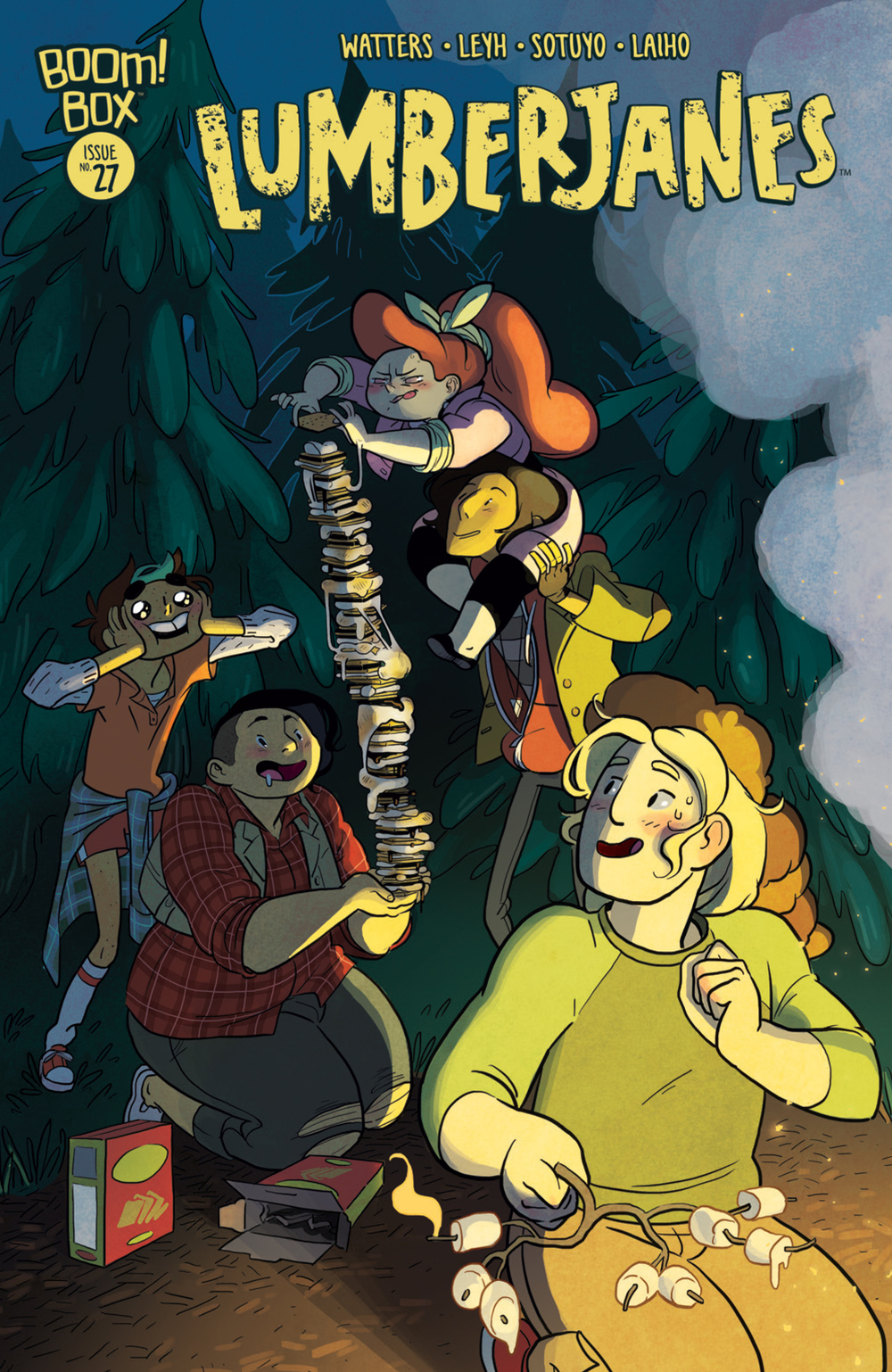

Artist: Ayme Sotuyo
Publisher: BOOM! Box
Source: BOOM! Studios DRC
★★★★☆
The Lumberjanes show up to rescue the Grand Lodge only to find out that they didn’t really need it. They were planning their own attempt to escape the giant bird’s nest – one that probably involved killing it. Apparently in the old days the Lumberjanes did a bit more killing of wild, supernatural creatures than they do now. And the girls are not cool with it. Well, Hes is cool with it and Jen pretends to go along with it.
The girls tell the Grand Lodge they’ll come up with an idea that doesn’t mean killing the giant bird. After all, up to that point it hadn’t hurt any one. Not really. Barney – hoping to be useful – becomes determined to come up with his own idea, too. By watching the bird he realizes that the nest is full of all kinds of random stuff because it’s trying to impress to small black bird. It’s looking for love but in all the wrong ways. Using his bird watching skills from his Scouting Lads handbook, he starts looking for a non-lethal way to fix things.
Hes helps him out a little. She’s a little dejected because her grandmother took the Roanoke girls’ side in everything.
But Barney and the girls manage to come up with a plan – we just don’t get to see it in action until the next issue. Laaaame. (Just kidding, I can’t wait to see how it turns out – and how the magical kittens contribute to it.)
Joyride #3
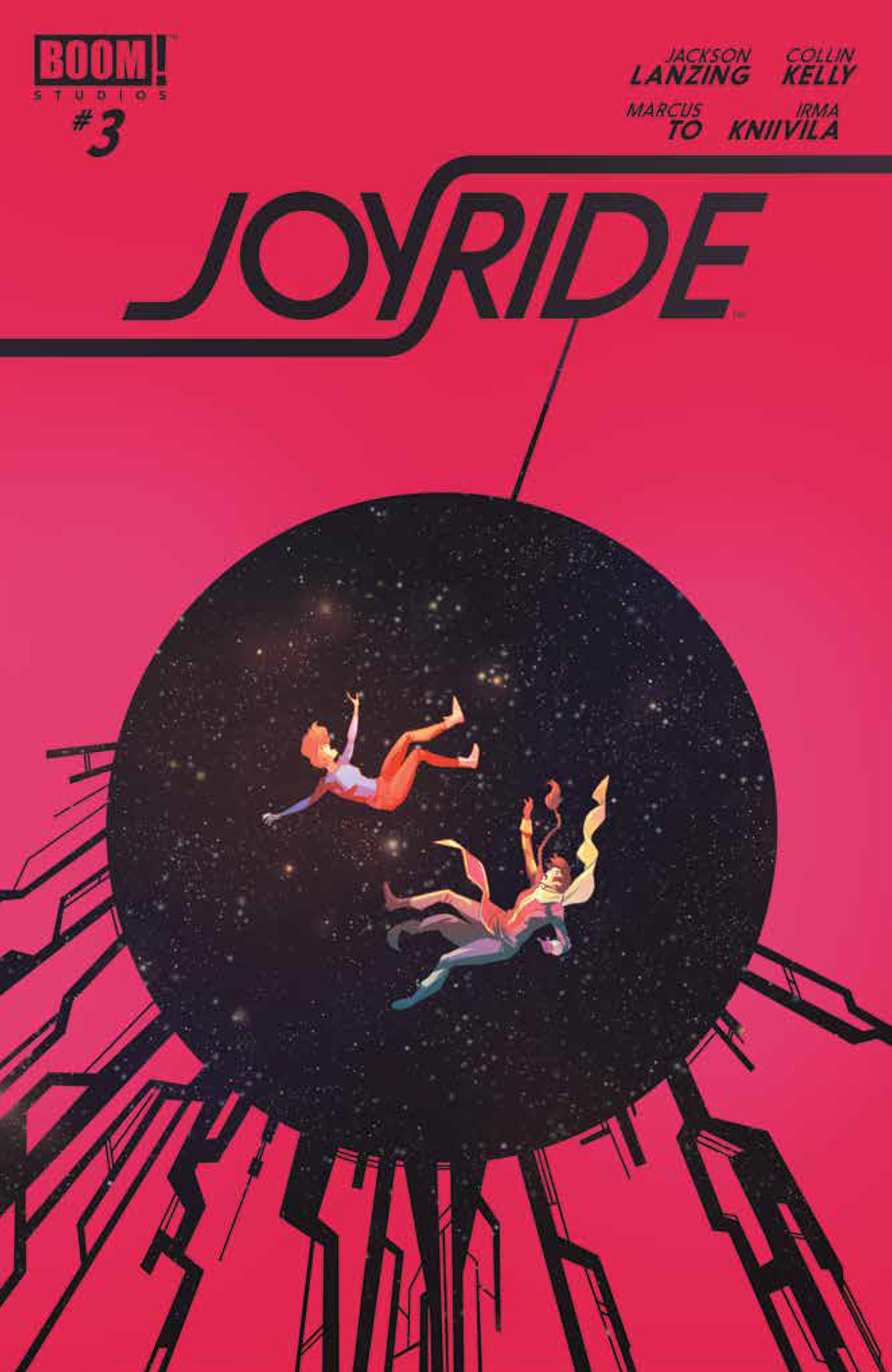

Artist: Marcus To
Publisher: BOOM! Studios
Source: BOOM! Studios DRC
★★★★☆
At the end of the last issue our band of heroes fled into a quarantine zone to escape their pursuers. It turns out that the quarantine zone was actually meant to keep people from coming in contact with a psychic-ish planet sized being. Unfortunately, they didn’t know that and they had to go somewhere. But they can’t just take off. When they get there they find that their engine is busted.
Catrin and Uma go out on a space walk but things don’t go as planned. They end up getting sucked toward the not-planet. They get psychically linked to it and to each other. This means they both get to flashback with one another. Both of these young women came from very different backgrounds. Uma’s mother was loving and just as deviant as she was back on Earth. She paid for it too.
Meanwhile Catrin – who is apparently albino and considered an ‘abomination’ by the government – is the daughter of one of the most tyrannical people on Earth. The link gives Catrin a better understanding of Uma – but knowing who her father is means Uma can never trust her.
Yikes.
At least the planet gets to take off and live it’s life jetting around the galaxy. Catrin and Uma inspired it! Before, you know, ruining any potential they had of being friends because of their tragic backstories. This book is so great. I love it.


Kylee’s Reads
Paknadel & Trakhanov’s Turncoat #4 (of 4)
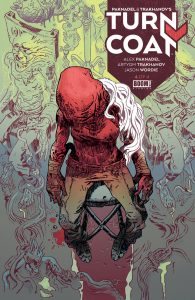

Artist: Artyom Trakhanov
Publisher: BOOM! Studios
Source: BOOM! Studios DRC
★★★★★
Like Alex Paknadel’s previous series, Arcadia, I’m envisioning a million stories that still could be told in the Turncoat universe, even as issue #4 wraps up the current one. In the final issue of this miniseries from BOOM! Studios, audiences are witness to the case coming to a head over the hybrid children. Marta’s stake in the case, as well as her motivations for previously betraying Management, are revealed and it is absolutely heart-wrenching and sympathizing. I should have seen it coming, but I definitely didn’t and between Paknadel’s writing and Trakhanov’s art, the last few pages were devastating even as they finished the story being told.
Trakhanov and colorist Jason Wordie continue to layer a fantastical world and set the scene for Paknadel’s writing through to the end. The angles Trakhanov uses and the coloring choices from Wordie help to keep the final reveal a mystery until the very end. Not your run-of-the-mill, humanity conquering the alien invaders story, this one will stick with readers long after the final page. Paknadel’s exploration of power vacuums and the tolerance of evil for the greater good is finely nuanced for such a short miniseries and leaves me confident in my continued praise for his writing. I can’t wait to see what this talented group of comics creators chooses to showcase next.


Jackson’s Reads
Uncanny X-Men #8
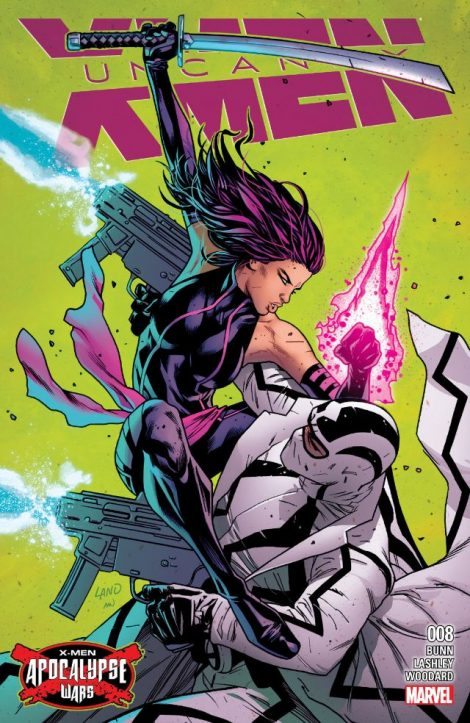
Author: Cullen Bunn
Artist: Ken Lashley
Publisher: Marvel Comics
★★★★☆
There was a conscious effort starting in around 2012, after the end of the Utopia era, to make the X-Men comics significantly more reader friendly. Since the “Manifest Destiny” crossover, the line became increasingly intertwined, with all of the books becoming significantly more related to the larger themes being addressed in the core story taking place in Uncanny X-Men. Brian Michael Bendis’ takeover of the franchise in 2012 opened things up by introducing the younger, time-displaced X-Men and focusing the universe around them. There were a lot of great stories told around that status quo but it tended to sideline characters and concepts that didn’t tie-in readily to the youngest members of the team.
That makes Uncanny X-Men #8 feel very at odds with both the line and the years of stories that have lead up to it. A part of the ongoing “Apocalypse Wars” crossover and written by Cullen Bunn and drawn by Ken Lashley, the issue depends on the idea of long buried secrets, most importantly, the relationship between Warren Worthington, Psylocke and Fantomex.
The three characters were the backbone of a homicidal love triangle back in Rick Remender’s run on Uncanny X-Force but the brawl between Betsy and the gun-toting Frenchman here is going to play very differently depending on how familiar readers are with the pair’s often complicated relationship. If you’re not up on Fantomex’s transformation into three different characters, Psylocke’s recent attempts to get over her addiction to murder and Hope and Betsy’s most recent attempt to permanently kill Fantomex, things might not be clear.
For me, and I expect readers familiar with these characters, even if they’re not familiar with their histories, it feels grounded. Betsy’s off her game, knowing that Fantomex is hiding things from her and Magneto may be doing the same, and she realizes that she’s being pushed into unleashing Archangel again in order to have a shot at stopping Clan Akkaba.
In a lot of ways, Uncanny X-Men #8 is the quintessential third-part-of-a-four-part-crossover but it’s all in service of a plot that demands reader’s attention. That’s noteworthy in X-Men comics today but it’s quality may vary based on readers’ familiarity with past stories, namely recent X-Force comics.
Superman #1
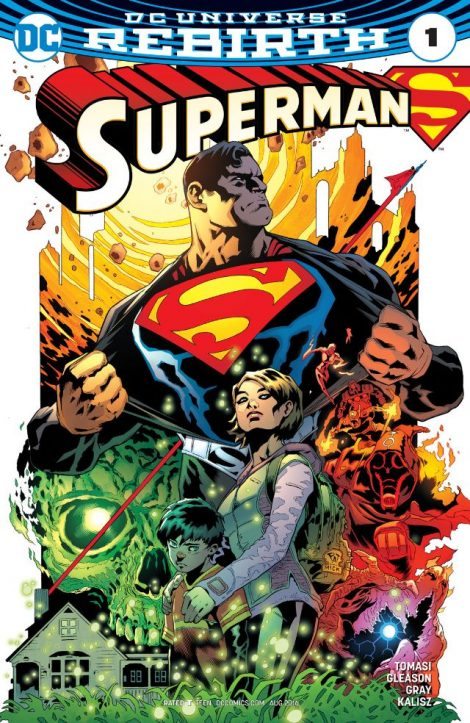
Author: Peter J. Tomasi
Artist: Patrick Gleason
Publisher: DC Comics
★★★★☆
More than any other character in the company’s stables, DC tends to respond to fan feedback on Superman. Do you want the biggest talent in the industry to do yet another origin story for him? They’ll get it done. Complain loud enough that you don’t want Chuck Austen on the book anymore? DC’ll take his name off the title and hand it off to a still unknown person using a pseudonym. Want New 52 Superman dead and Pre-Flashpoint Superman back? That young guy’s in the ground faster than you can say “Rebirth.”
The problem therein is that you have to give an in-story justification for why these fan demanded changes can happen and it’s hard to get over what DC has done to bring back the old Clark Kent. Even as the ‘80s movie caricature of a comic book nerd that I am, I have trouble jumping through the mental hoops it takes that connect “Flashpoint,” “Convergence,” “The Death of Superman,” “The Last Days of Superman” and a host of Dan Jurgens-era Superman stories to get to where we are now. The thing is, when creators are able to work around that origin and focus on the characters, it tends to work.
Superman #1 mostly does that by telling the story through Jon White, alt-universe Clark’s son and the new Superboy. Jon’s still growing into being a pre-teen and the associated feelings and frustrations that come with it and his anger, inadequacies and frustrations are only magnified when he unleashes his Kryptonian abilities.
The issue’s written by Peter Tomasi and drawn by Patrick Gleason and in a lot of ways, feels reminiscent to what the duo did with Damian Wayne way back during their run on Batman and Robin in 2011. Jon’s defined by what he can do and what he should do and he’s both frustrated by his inability to let his powers loose, he’s terrified by what they can do unchecked. A scene where he unleashes his heat vision is terrifying and beautiful, showing both a sense of childlike, fruitless rage and the widespread destruction he’s capable of unleashing.
Superman #1 is light, even compared to the rest of the debut issues of the DC Rebirth relaunches but it’s grounded in character. It’s a reflection of the optimism and sense of wish fulfillment that’s intrinsic to Superman while telling a thoroughly grounded story about the ugly, frustrating side of growing up. A last page reveal seems to focus the story around Clark and Jon’s relationship and it’s a compelling hook that doesn’t have the weight of years of Kryptonian continuity. If there’s an entry point in DC’s new wave of Superman comics, this is it.
The Dark Knight Returns: The Last Crusade
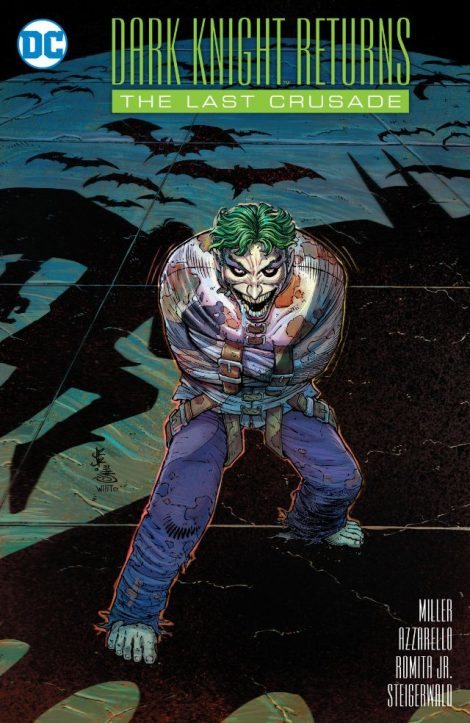
Author: Frank Miller and Brian Azzarello
Artist: John Romita Jr.
Publisher: DC Comics
★★★★★
While The Dark Knight Returns contains some of the most iconic moments in Batman’s long history, the actual mechanics of the story often tend to be overlooked. Reading it today, the reveal that Batman’s retirement from crime hinged on the death of Jason Todd feels a little prophetic, with the iconic graphic novel’s story predating “The Death in the Family” crossover by a few months. However, Jason’s death was long coming, something this week’s superb The Dark Knight Returns: The Last Crusade one-shot trades in with aplomb, however, it’s neatest tricks require some context to fully appreciate.
When we talk about Jason Todd’s term as Robin, we tend to focus on an ahistorical moment, an in-house advertisement in Batman #427, a black and white advertisement with two numbers asking readers to call in and decide the fate of the character. It’s an enduring, bizarre moment of comic book history, arguably the first moment in the medium’s history where the behind-the-scenes goings-on are both more memorable and more important than what happened on the page.
While it’s not necessarily a problem, this reading of the moment tends to flatten both what makes Jason a memorable character and what made him a doomed one, regardless of how many people called that number. See, DC never seemed exactly sure of what to do with the second Robin. In Batman, Jason Todd was the sullen, violent teen, desperate to exorcise his personal demons under the auspices of fighting for justice.
In Detective Comics, he was Jay, a chummy goofball helping the caped crusader battle various threats to the night. Ultimately, that division left Jason on the cutting block. He didn’t have the consistent meaning in life that he ever could in death and, as such, his demise was constantly foreshadowed in the ‘80s, including a reference to his death, which had yet to happen, in The Dark Knight Returns.
That prophecy hangs over The Last Crusade, which tells the story of how Jason died in the alternate universe of Frank Miller’s dystopian vision. As an aging Batman considers retiring and ceding his responsibilities to Jason Todd, a series of strange crimes targeting Gotham’s economic elite forces Bruce to question his limits and his own psychological failings.
Written by Frank Miller and Brian Azzarello with art by John Romita Jr., The Last Crusade feels straight out of 1986 in the best way possible. It’s a nostalgic comic, mostly established with Romita’s pencils. For his decades of work, Romita’s art is mostly remembered for his square-jawed Jack Kirby-esque run on Uncanny X-Men and Daredevil. Here, however, he’s channeling Miller at his best and turning in a fully realized, stunning image. His Joker and Killer Croc look straight out of Miller’s most iconic comics and he uses the rigid panels of The Dark Knight Returns to create a true companion to the original piece.
Visually, The Last Crusade is incredibly strong and its text actively separates itself from Miller’s original story. While I’ve had problems with Azzarello’s work on The Master Race, here, he focuses almost entirely on Bruce’s inner struggles. With his body failing him, Batman’s forced to examine his own failings, both as a mentor and surrogate father. He recognizes that he’s never quite been able to make Jason realize the difference between justice and vengeance and failed to save his newest ward in the same way he was Dick.
He sees the way Jason savors the pain and violence he inflicts and feels powerless to convince him to change. For the first time in decades, it showcases the tragedy of Jason Todd and Bruce’s failings, both to save his sidekick in a fatal situation, as well as when he could have been the father he needed to be. It acknowledges that Jason Todd was doomed long before that fatal encounter with the Joker without erasing the tragedy of his demise and it makes the moral compromises of The Dark Knight Return both understandable and terrifyingly human.

